Seyed Jalaleddin Mousavirad
Robust Energy Consumption Prediction with a Missing Value-Resilient Metaheuristic-based Neural Network in Mobile App Development
Sep 21, 2023



Abstract:Energy consumption is a fundamental concern in mobile application development, bearing substantial significance for both developers and end-users. Moreover, it is a critical determinant in the consumer's decision-making process when considering a smartphone purchase. From the sustainability perspective, it becomes imperative to explore approaches aimed at mitigating the energy consumption of mobile devices, given the significant global consequences arising from the extensive utilisation of billions of smartphones, which imparts a profound environmental impact. Despite the existence of various energy-efficient programming practices within the Android platform, the dominant mobile ecosystem, there remains a need for documented machine learning-based energy prediction algorithms tailored explicitly for mobile app development. Hence, the main objective of this research is to propose a novel neural network-based framework, enhanced by a metaheuristic approach, to achieve robust energy prediction in the context of mobile app development. The metaheuristic approach here plays a crucial role in not only identifying suitable learning algorithms and their corresponding parameters but also determining the optimal number of layers and neurons within each layer. To the best of our knowledge, prior studies have yet to employ any metaheuristic algorithm to address all these hyperparameters simultaneously. Moreover, due to limitations in accessing certain aspects of a mobile phone, there might be missing data in the data set, and the proposed framework can handle this. In addition, we conducted an optimal algorithm selection strategy, employing 13 metaheuristic algorithms, to identify the best algorithm based on accuracy and resistance to missing values. The comprehensive experiments demonstrate that our proposed approach yields significant outcomes for energy consumption prediction.
A Metaheuristic-based Machine Learning Approach for Energy Prediction in Mobile App Development
Jun 16, 2023Abstract:Energy consumption plays a vital role in mobile App development for developers and end-users, and it is considered one of the most crucial factors for purchasing a smartphone. In addition, in terms of sustainability, it is essential to find methods to reduce the energy consumption of mobile devices since the extensive use of billions of smartphones worldwide significantly impacts the environment. Despite the existence of several energy-efficient programming practices in Android, the leading mobile ecosystem, machine learning-based energy prediction algorithms for mobile App development have yet to be reported. Therefore, this paper proposes a histogram-based gradient boosting classification machine (HGBC), boosted by a metaheuristic approach, for energy prediction in mobile App development. Our metaheuristic approach is responsible for two issues. First, it finds redundant and irrelevant features without any noticeable change in performance. Second, it performs a hyper-parameter tuning for the HGBC algorithm. Since our proposed metaheuristic approach is algorithm-independent, we selected 12 algorithms for the search strategy to find the optimal search algorithm. Our finding shows that a success-history-based parameter adaption for differential evolution with linear population size (L-SHADE) offers the best performance. It can improve performance and decrease the number of features effectively. Our extensive set of experiments clearly shows that our proposed approach can provide significant results for energy consumption prediction.
A Cluster-Based Opposition Differential Evolution Algorithm Boosted by a Local Search for ECG Signal Classification
May 04, 2023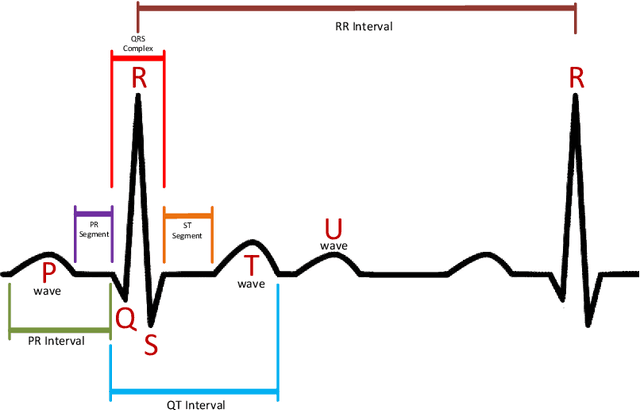
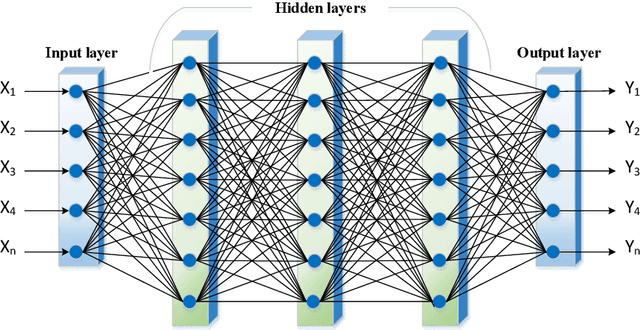
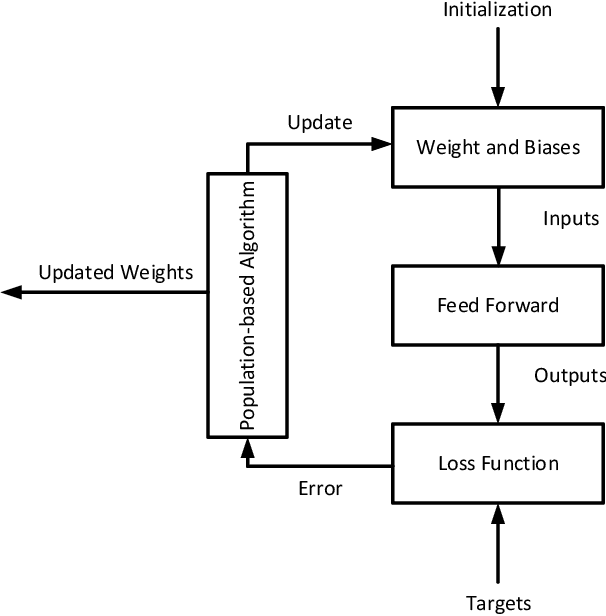
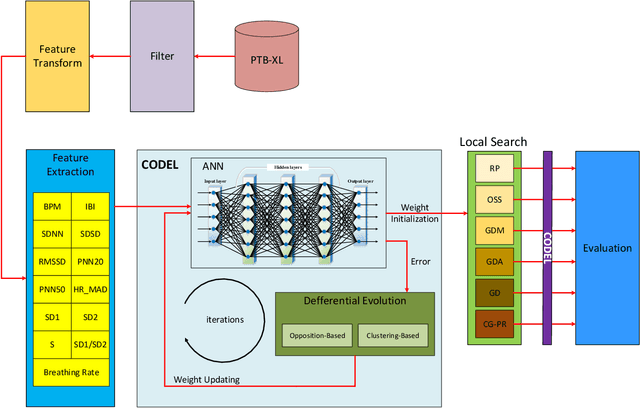
Abstract:Electrocardiogram (ECG) signals are recordings of the heart's electrical activity and are widely used in the medical field to diagnose various cardiac conditions and monitor heart function. The accurate classification of ECG signals is crucial for the early detection and treatment of heart-related diseases. This paper proposes a novel approach based on an improved differential evolution (DE) algorithm for ECG signal classification. To this end, after the preprocessing step, we extracted several features such as BPM, IBI, and SDNN. Then, the features are fed into a multi-layer perceptron (MLP). While MLPs are still widely used for ECG signal classification, using gradient-based training methods, the most widely used algorithm for the training process, has significant disadvantages, such as the possibility of being stuck in local optimums. Population-based metaheuristic techniques have been effectively used to address this. This paper employs an enhanced differential evolution (DE) algorithm for the training process as one of the most effective population-based algorithms. To this end, we improved DE based on a clustering-based strategy, opposition-based learning, and a local search. Clustering-based strategies can act as crossover operators, while the goal of the opposition operator is to improve the exploration of the DE algorithm. The weights and biases found by the improved DE algorithm are then fed into six gradient-based local search algorithms. In other words, the weights found by the DE are employed as an initialization point. Therefore, we introduced six different algorithms for the training process (in terms of different local search algorithms). In an extensive set of experiments, we showed that our proposed training algorithm could provide better results than the conventional training algorithms.
A Novel Plagiarism Detection Approach Combining BERT-based Word Embedding, Attention-based LSTMs and an Improved Differential Evolution Algorithm
May 03, 2023



Abstract:Detecting plagiarism involves finding similar items in two different sources. In this article, we propose a novel method for detecting plagiarism that is based on attention mechanism-based long short-term memory (LSTM) and bidirectional encoder representations from transformers (BERT) word embedding, enhanced with optimized differential evolution (DE) method for pre-training and a focal loss function for training. BERT could be included in a downstream task and fine-tuned as a task-specific BERT can be included in a downstream task and fine-tuned as a task-specific structure, while the trained BERT model is capable of detecting various linguistic characteristics. Unbalanced classification is one of the primary issues with plagiarism detection. We suggest a focal loss-based training technique that carefully learns minority class instances to solve this. Another issue that we tackle is the training phase itself, which typically employs gradient-based methods like back-propagation for the learning process and thus suffers from some drawbacks, including sensitivity to initialization. To initiate the BP process, we suggest a novel DE algorithm that makes use of a clustering-based mutation operator. Here, a winning cluster is identified for the current DE population, and a fresh updating method is used to produce potential answers. We evaluate our proposed approach on three benchmark datasets ( MSRP, SNLI, and SemEval2014) and demonstrate that it performs well when compared to both conventional and population-based methods.
Population-based JPEG Image Compression: Problem Re-Formulation
Dec 13, 2022Abstract:The JPEG standard is widely used in different image processing applications. One of the main components of the JPEG standard is the quantisation table (QT) since it plays a vital role in the image properties such as image quality and file size. In recent years, several efforts based on population-based metaheuristic (PBMH) algorithms have been performed to find the proper QT(s) for a specific image, although they do not take into consideration the user's opinion. Take an android developer as an example, who prefers a small-size image, while the optimisation process results in a high-quality image, leading to a huge file size. Another pitfall of the current works is a lack of comprehensive coverage, meaning that the QT(s) can not provide all possible combinations of file size and quality. Therefore, this paper aims to propose three distinct contributions. First, to include the user's opinion in the compression process, the file size of the output image can be controlled by a user in advance. Second, to tackle the lack of comprehensive coverage, we suggest a novel representation. Our proposed representation can not only provide more comprehensive coverage but also find the proper value for the quality factor for a specific image without any background knowledge. Both changes in representation and objective function are independent of the search strategies and can be used with any type of population-based metaheuristic (PBMH) algorithm. Therefore, as the third contribution, we also provide a comprehensive benchmark on 22 state-of-the-art and recently-introduced PBMH algorithms on our new formulation of JPEG image compression. Our extensive experiments on different benchmark images and in terms of different criteria show that our novel formulation for JPEG image compression can work effectively.
Energy-Aware JPEG Image Compression: A Multi-Objective Approach
Sep 09, 2022
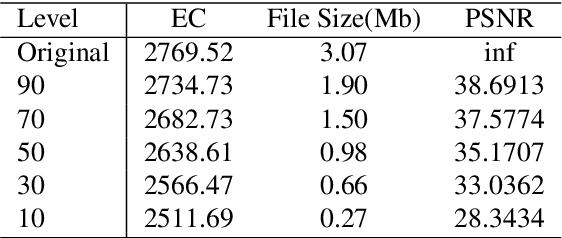
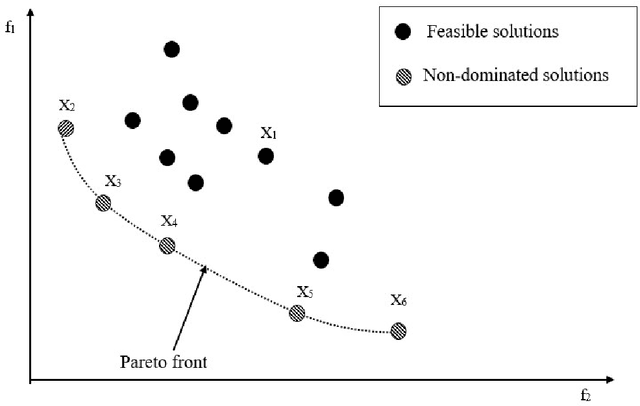
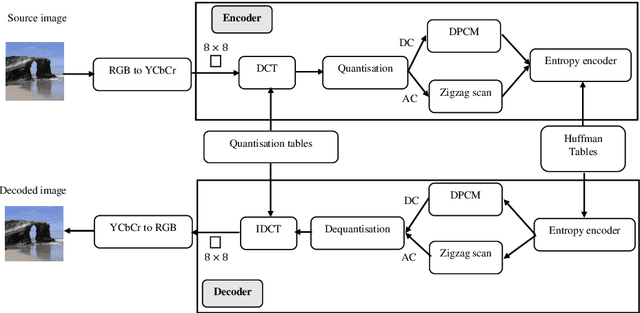
Abstract:Customer satisfaction is crucially affected by energy consumption in mobile devices. One of the most energy-consuming parts of an application is images. While different images with different quality consume different amounts of energy, there are no straightforward methods to calculate the energy consumption of an operation in a typical image. This paper, first, investigates that there is a correlation between energy consumption and image quality as well as image file size. Therefore, these two can be considered as a proxy for energy consumption. Then, we propose a multi-objective strategy to enhance image quality and reduce image file size based on the quantisation tables in JPEG image compression. To this end, we have used two general multi-objective metaheuristic approaches: scalarisation and Pareto-based. Scalarisation methods find a single optimal solution based on combining different objectives, while Pareto-based techniques aim to achieve a set of solutions. In this paper, we embed our strategy into five scalarisation algorithms, including energy-aware multi-objective genetic algorithm (EnMOGA), energy-aware multi-objective particle swarm optimisation (EnMOPSO), energy-aware multi-objective differential evolution (EnMODE), energy-aware multi-objective evolutionary strategy (EnMOES), and energy-aware multi-objective pattern search (EnMOPS). Also, two Pareto-based methods, including a non-dominated sorting genetic algorithm (NSGA-II) and a reference-point-based NSGA-II (NSGA-III) are used for the embedding scheme, and two Pareto-based algorithms, EnNSGAII and EnNSGAIII, are presented. Experimental studies show that the performance of the baseline algorithm is improved by embedding the proposed strategy into metaheuristic algorithms.
Machine Learning Testing in an ADAS Case Study Using Simulation-Integrated Bio-Inspired Search-Based Testing
Mar 22, 2022
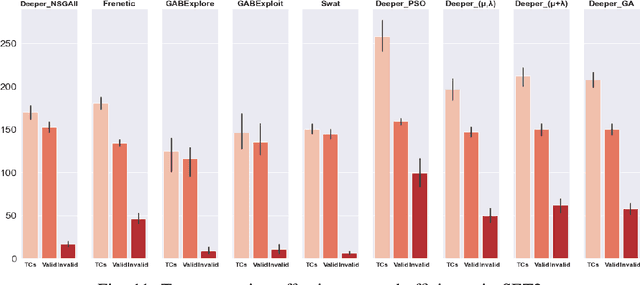


Abstract:This paper presents an extended version of Deeper, a search-based simulation-integrated test solution that generates failure-revealing test scenarios for testing a deep neural network-based lane-keeping system. In the newly proposed version, we utilize a new set of bio-inspired search algorithms, genetic algorithm (GA), $({\mu}+{\lambda})$ and $({\mu},{\lambda})$ evolution strategies (ES), and particle swarm optimization (PSO), that leverage a quality population seed and domain-specific cross-over and mutation operations tailored for the presentation model used for modeling the test scenarios. In order to demonstrate the capabilities of the new test generators within Deeper, we carry out an empirical evaluation and comparison with regard to the results of five participating tools in the cyber-physical systems testing competition at SBST 2021. Our evaluation shows the newly proposed test generators in Deeper not only represent a considerable improvement on the previous version but also prove to be effective and efficient in provoking a considerable number of diverse failure-revealing test scenarios for testing an ML-driven lane-keeping system. They can trigger several failures while promoting test scenario diversity, under a limited test time budget, high target failure severity, and strict speed limit constraints.
HMS-OS: Improving the Human Mental Search Optimisation Algorithm by Grouping in both Search and Objective Space
Dec 03, 2021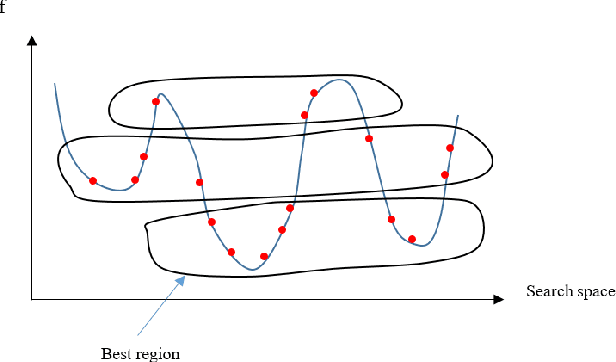
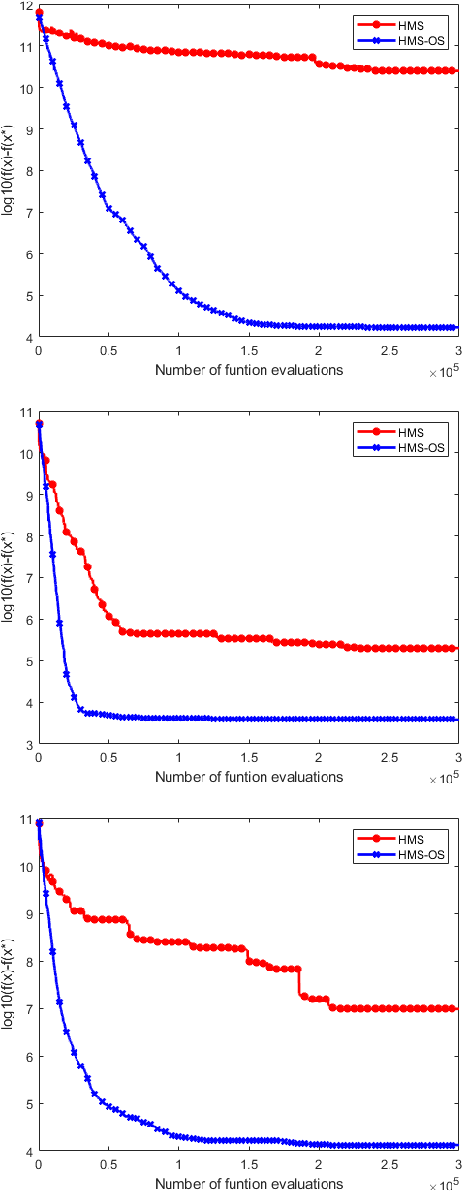
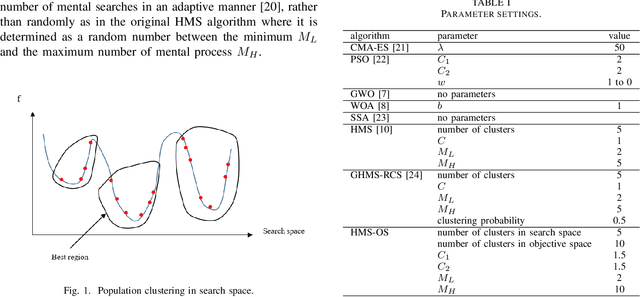

Abstract:The human mental search (HMS) algorithm is a relatively recent population-based metaheuristic algorithm, which has shown competitive performance in solving complex optimisation problems. It is based on three main operators: mental search, grouping, and movement. In the original HMS algorithm, a clustering algorithm is used to group the current population in order to identify a promising region in search space, while candidate solutions then move towards the best candidate solution in the promising region. In this paper, we propose a novel HMS algorithm, HMS-OS, which is based on clustering in both objective and search space, where clustering in objective space finds a set of best candidate solutions whose centroid is then also used in updating the population. For further improvement, HMSOS benefits from an adaptive selection of the number of mental processes in the mental search operator. Experimental results on CEC-2017 benchmark functions with dimensionalities of 50 and 100, and in comparison to other optimisation algorithms, indicate that HMS-OS yields excellent performance, superior to those of other methods.
MCS-HMS: A Multi-Cluster Selection Strategy for the Human Mental Search Algorithm
Nov 20, 2021



Abstract:Population-based metaheuristic algorithms have received significant attention in global optimisation. Human Mental Search (HMS) is a relatively recent population-based metaheuristic that has been shown to work well in comparison to other algorithms. However, HMS is time-consuming and suffers from relatively poor exploration. Having clustered the candidate solutions, HMS selects a winner cluster with the best mean objective function. This is not necessarily the best criterion to choose the winner group and limits the exploration ability of the algorithm. In this paper, we propose an improvement to the HMS algorithm in which the best bids from multiple clusters are used to benefit from enhanced exploration. We also use a one-step k-means algorithm in the clustering phase to improve the speed of the algorithm. Our experimental results show that MCS-HMS outperforms HMS as well as other population-based metaheuristic algorithms
An LSTM-based Plagiarism Detection via Attention Mechanism and a Population-based Approach for Pre-Training Parameters with imbalanced Classes
Oct 17, 2021



Abstract:Plagiarism is one of the leading problems in academic and industrial environments, which its goal is to find the similar items in a typical document or source code. This paper proposes an architecture based on a Long Short-Term Memory (LSTM) and attention mechanism called LSTM-AM-ABC boosted by a population-based approach for parameter initialization. Gradient-based optimization algorithms such as back-propagation (BP) are widely used in the literature for learning process in LSTM, attention mechanism, and feed-forward neural network, while they suffer from some problems such as getting stuck in local optima. To tackle this problem, population-based metaheuristic (PBMH) algorithms can be used. To this end, this paper employs a PBMH algorithm, artificial bee colony (ABC), to moderate the problem. Our proposed algorithm can find the initial values for model learning in all LSTM, attention mechanism, and feed-forward neural network, simultaneously. In other words, ABC algorithm finds a promising point for starting BP algorithm. For evaluation, we compare our proposed algorithm with both conventional and population-based methods. The results clearly show that the proposed method can provide competitive performance.
 Add to Chrome
Add to Chrome Add to Firefox
Add to Firefox Add to Edge
Add to Edge